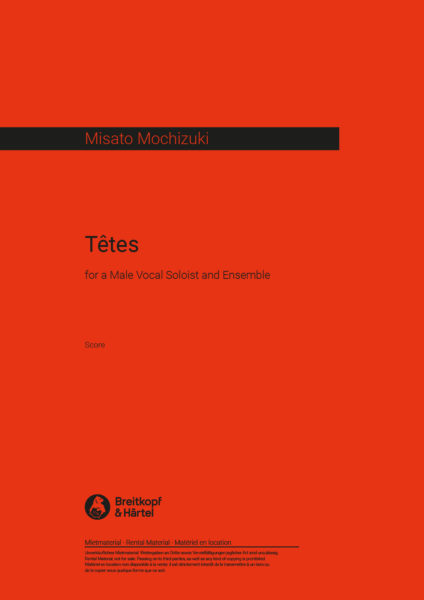Misato Mochizuki (*1969) Têtes
Text von Dominique Quélen nach „Kwaidan“ von Lafcadio Hearn [Bar,Ens] 2017 Dauer: 38'
Bar(auch Sprecher und Schauspieler) – Fl(Picc.A-Fl.B-Fl).Ob(Eh).Klar(Eb-Klar.B-Klar.Kb-Klar) – Trp(Double Bell) – Schl – Koto – Vc – Kb
Uraufführung: Donaueschingen, 22. Oktober 2017
Têtes ist ein Werk, das auf die japanische Tradition des Rakugo zurückgeht. Es ist ein eher komisches literarisch-linguistisches Bühnenstück, das bis ins 17. Jahrhundert zurückreicht und in minimalistischem Rahmen mit einem Erzähler und einigen Requisiten operiert. Der Erzähler erzählt eine kurze Geschichte und spielt sämtliche Rollen der handelnden Personen selbst. Für unser Projekt szenischer Poesie habe ich Dominique Quélen gebeten, zum einen Geschichten, inspiriert von den traditionellen japanischen Erzählungen Lafcadio Hearns in „Kwaidan – oder Geschichte und Erforschung merkwürdiger Dinge“, zu schreiben, zum anderen eigene Geschichten zu erfinden zum übergreifenden Thema „Kopf“.
In den meisten Kulturen bestanden – oder bestehen noch immer – Exekutionen im Abtrennen des Kopfes vom Körper (in Frankreich Guillotine, in Japan Harakiri-Köpfungen, oder – in unserer Zeit – Geiselenthauptungen durch Anhänger der Terrormiliz Islamischer Staat). Das Erschreckende dieser Aktionen ist – nebst der Tatsache, dass diesen Menschen das Leben genommen wird -, dass gewissermaßen auch deren Identität vernichtet wird. Gesicht und Gehirn sind das Außen und das Innen der Persönlichkeit, das, was uns einzigartig macht.
In diesen Geschichten wird es um Wesen gehen, die den Kopf verlieren (im wörtlichen wie im übertragenen Sinn), oder die Köpfe hinzugewinnen; Wesen, die nur aus Kopf bestehen, andere, deren Gesicht ausgelöscht ist, und wieder andere, die sich multiplizieren. Jede dieser Geschichten stellt auf ihre Art Fragen nach unserer eigenen Identität, unserer Unterschiedlichkeit, und evoziert mitunter bioethische Konflikte, die mit der Technologie von Robotern oder dem Klonen im Zusammenhang stehen.
(Misato Mochizuki, 2017)
| 1. Prologue |
| 2. Diplomatie |
| 3. Le Fantôme à la tête coupée |
| 4. La Multiplication des Samouraïs |
| 5. Le Fantôme sans visage |
| 6. Epilogue |









